Related Research Articles

Diana Vreeland was an American fashion columnist and editor. She worked for the fashion magazine Harper's Bazaar and as editor-in-chief at Vogue, later becoming a special consultant to the Costume Institute of the Metropolitan Museum of Art. She was named on the International Best Dressed List Hall of Fame in 1964. Vreeland coined the term youthquake in 1965.
Vogue is an American monthly fashion and lifestyle magazine that covers various topics, including haute couture fashion, beauty, culture, living, and runway. Based at One World Trade Center in the Financial District of Lower Manhattan, Vogue began in 1892 as a weekly newspaper before becoming a monthly magazine years later. Since its founding, Vogue has featured numerous actors, musicians, models, athletes, and other prominent celebrities. The largest issue published by Vogue magazine was the September 2012 edition, containing 900 pages.
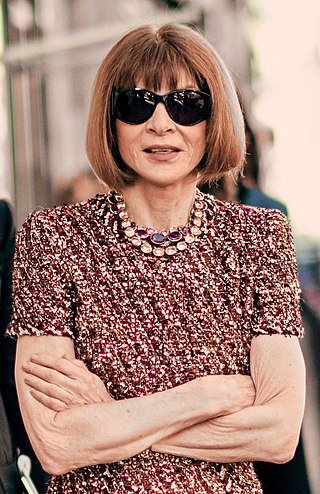
Dame Anna Wintour is a British and American media executive based in New York City who has served as editor-in-chief of Vogue since 1988 and Global Chief Content Officer for Condé Nast since 2020; she is also the artistic director of Condé Nast and the Global Editorial Director of Vogue. With her trademark pageboy bob haircut and dark sunglasses, Wintour has become an important figure in much of the fashion world, praised for her eye for emerging fashion trends. Her reportedly aloof and demanding personality has earned her the nickname "Nuclear Wintour".

Isabella "Issie" Blow was an English magazine editor. As the muse of hat designer Philip Treacy, she is credited with discovering the models Stella Tennant and Sophie Dahl as well as propelling and continually advocating the career of fashion designer Alexander McQueen, beginning when she bought the entirety of his explosive premier show inspired by Jack the Ripper.
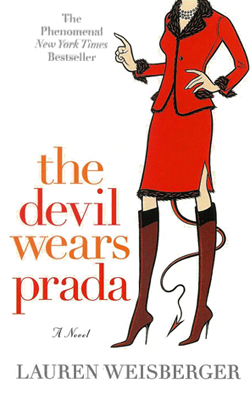
The Devil Wears Prada is a 2003 novel by Lauren Weisberger about a young woman who is hired as a personal assistant to a powerful fashion magazine editor, a job that becomes nightmarish as she struggles to keep up with her boss's grueling schedule and demeaning demands. It spent six months on the New York Times bestseller list and became the basis for the 2006 film of the same name, starring Meryl Streep, Anne Hathaway, and Emily Blunt. The novel is considered by many to be an example of the "chick lit" genre.

Lauren Weisberger is an American writer best known for her 2003 bestseller The Devil Wears Prada, a roman à clef of her experience as an assistant to Vogue editor-in-chief Anna Wintour. Weisberger has worked as a writer and editor for magazines such as Vogue and Departures before writing her first novel The Devil Wears Prada. She has since worked on the film adaptation of her novel and has published seven other novels.

Tatjana Patitz was a German model. She achieved international prominence in the 1980s and 1990s representing fashion designers on runways and in magazines such as Elle, Harper's Bazaar, and Vogue. She was one of the big five supermodels who appeared in the 1990 music video "Freedom! '90" by George Michael, and she was associated with the editorial, advertising, and fine-art works of photographers Herb Ritts and Peter Lindbergh.
Elizabeth Jane Tilberis was a British fashion magazine editor of Manx and English ancestry.

The Devil Wears Prada is a 2006 American comedy-drama film directed by David Frankel and produced by Wendy Finerman. The screenplay, written by Aline Brosh McKenna, is based on Lauren Weisberger's 2003 novel of the same name. The film adaptation stars Meryl Streep as Miranda Priestly, a powerful fashion magazine editor, and Anne Hathaway as Andrea "Andy" Sachs, a college graduate who goes to New York City and lands a job as Priestly's co-assistant. Emily Blunt and Stanley Tucci co-star as co-assistant Emily Charlton and art director Nigel Kipling, respectively. Simon Baker and Adrian Grenier play pivotal supporting roles.
Victoria Rowland, known both professionally and socially as Plum Sykes, is an English-born fashion journalist, novelist, and socialite.

André Leon Talley was an American fashion journalist, stylist, creative director, and editor-at-large of Vogue magazine. He was the magazine's fashion news director from 1983 to 1987, its first African-American male creative director from 1988 to 1995, and then its editor-at-large from 1998 to 2013. Often regarded as a fashion icon, he was known for supporting emerging designers and advocating for diversity in the fashion industry; while the capes, kaftans, and robes he wore became his trademark look. Talley also served on the judging panel for America's Next Top Model.
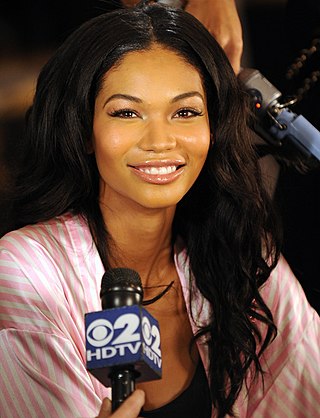
Chanel Iman Robinson is an American model who has worked as a Victoria's Secret Angel. Vogue Paris declared her as one of the top 30 models of the 2000s.

Rosie Alice Huntington-Whiteley is an English model. She is best known for her work for lingerie retailer Victoria's Secret, formerly being one of their brand "Angels", for being the face of Burberry's 2011 brand fragrance Burberry Body, for her work with Marks & Spencer, and, most recently, for her artistic collaboration with denim-focused fashion brand Paige.

Joan Juliet Buck is an American writer and actress. She was the editor-in-chief of French Vogue from 1994 to 2001, the only American ever to have edited a French magazine. She was contributing editor to Vogue and Vanity Fair for many years, and writes for Harper's Bazaar. The author of two novels, she published a memoir, The Price of Illusion, in 2017. In 2020, she was nominated for the Pushcart Prize for her short story, “Corona Diary.”
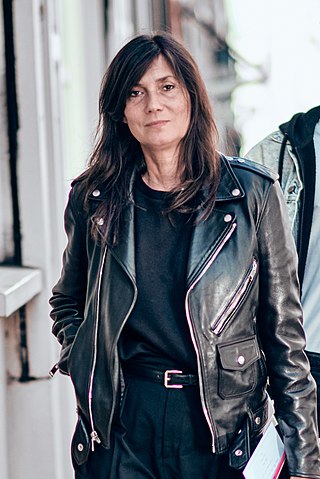
Emmanuelle Alt is a French fashion editor who was the editor-in-chief of Vogue Paris from February 2011, succeeding Carine Roitfeld, to May 2021.
Pamela Rosalind Grace Coddington is a Welsh former model and former creative director at-large of American Vogue magazine. Coddington is known for the creation of large, complex and dramatic photoshoots. A Guardian profile wrote that she "has produced some of fashion's most memorable imagery. Her pictures might be jolly and decadent or moody and mysterious."
Anna Harvey became Editorial Director of Condé Nast New Markets in 1997, was former Deputy Editor of British Vogue and former stylist and confidante to Diana, Princess of Wales. Her career at Condé Nast Publications spanned more than 30 years and she was regarded as one of the most significant contributors to the fashion industry.

Imaan Hammam is a Dutch fashion model. As of 2020, she has appeared on the cover of Vogue 18 times, four times on the American edition. She currently ranks on models.com's "Industry Icons" and was ranked on its "Top Sexiest Models" lists. As of 2021, she has appeared on The Big Four covers of Vogue.

Jennifer Hocking (1929–2011) was an Australian-born British-based fashion model in the 1950s and early 1960s, who then became fashion editor of Harper's Bazaar and Queen. Whilst there, she gave Anna Wintour her first magazine job. Hocking then pursued fashion design, before rediscovering success as a mature model in the 1990s, when she was described as a "grande dame" after her appearance in Mario Testino's shoots for Burberry.
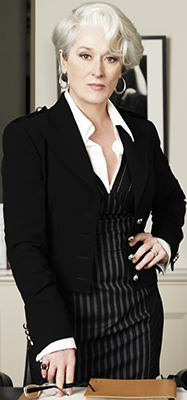
Miranda Priestly is a character in Lauren Weisberger's 2003 novel The Devil Wears Prada, portrayed by Meryl Streep in the 2006 film adaptation of the novel.
References
- 1 2 3 4 5 6 Fromm, Emily (September 16, 2003). "So What Do You Do, Kate Betts?". mediabistro.com . Jupitermedia. Retrieved June 11, 2010.
- 1 2 3 4 5 6 Betts, Kate. "Kate Betts". katebetts.com. Retrieved June 11, 2010.
- ↑ Betts, Katherine Hadley (1986). "Beauty in the Streets: The Impact of Student-Worker Action on French Political Consciousness in the Events of May, 1968".
{{cite journal}}: Cite journal requires|journal=(help) - 1 2 3 4 5 6 7 Egan, Maura (January 17, 2000). "Betts Intentions". New York . K-III Communications . Retrieved June 11, 2010.
- 1 2 3 4 5 Gray, Kevin (September 13, 1999). "The Summer of Her Discontent". New York . K-III Communications . Retrieved August 14, 2009.
- 1 2 Jacobs, Alexandra (June 10, 2001). "Good Witch Glenda Comes to Bazaar as Classy, Chilly Kate Gets Gate". New York Observer . Archived from the original on August 27, 2008. Retrieved June 11, 2010.
- ↑ "Betts gets the boot from Harper's Bazaar". Media Life. June 1, 2001. Archived from the original on June 5, 2010. Retrieved June 11, 2010.
- ↑ Betts, Kate (April 13, 2003). "Anna Dearest". The New York Times . Retrieved June 11, 2010.
- ↑ Goldblatt, Mark (June 10, 2003). "The Devil & The Gray Lady". National Review Online. Archived from the original on January 29, 2013. Retrieved June 12, 2003.
- ↑ "Review of Kate Betts' review". Gawker.com . Gawker Media. April 13, 2003. Archived from the original on July 4, 2009. Retrieved June 12, 2010.
- ↑ Spiers, Elizabeth (April 24, 2003). "When Personal Assistants Attack". Salon.com . Salon Media Group. Archived from the original on October 25, 2009. Retrieved June 12, 2003.
- ↑ "Revenge against hot NY served up cold". Irish Independent . Independent News and Media. November 6, 2005. Retrieved June 12, 2010.
- ↑ Friedman, Jon (April 19, 2004). "Time makes a fashionable bet on Betts". MarketWatch . Dow Jones . Retrieved June 12, 2010.
- ↑ Kelly, Keith (September 4, 2009). "Now, it's Time to go for Style & Design". The New York Post . News Corporation . Retrieved June 12, 2010.